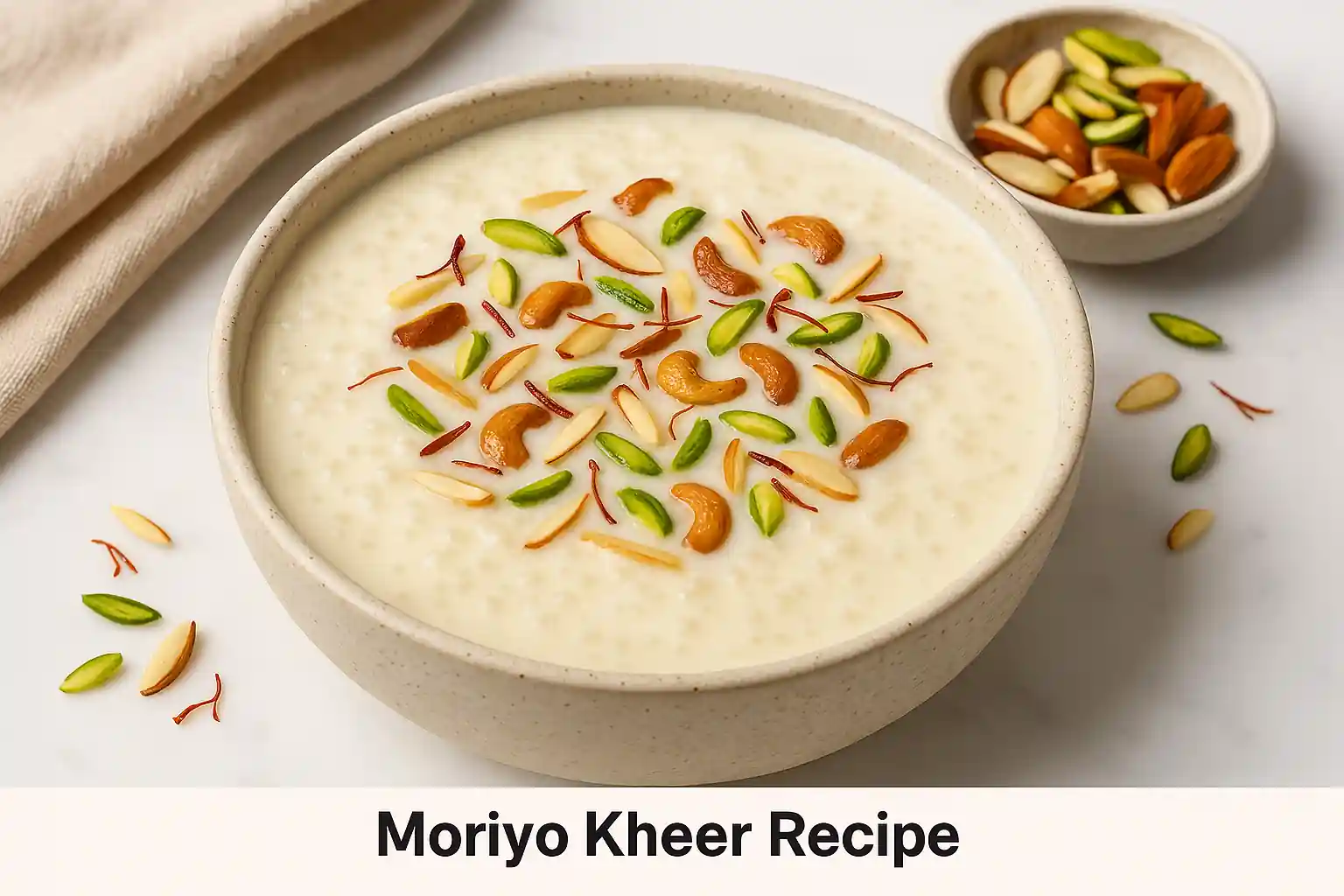Moriyo Kheer Recipe: A Fasting Delight with Barnyard Millet
In the rich tapestry of Indian cuisine, few dishes resonate with tradition, purity, and comfort as deeply as kheer. Whether it’s a festival, a religious fast, or a simple craving for something sweet, ki kheer (or pudding) often finds its way into the heart of the celebration. Among the many variations, moriyo kheer, made from barnyard millet, holds a special place, especially during fasting days and Navratri. This delicious, creamy dessert is more than just a sweet dish—it’s a symbol of devotion, health, and culinary heritage.
What is Moriyo and Why Use It in Kheer?
Moriyo, also known as sama, samak, samak rice, or samo, is a type of barnyard millet used extensively during fasts (vrat). These tiny white grains resemble broken rice and are easy to digest, gluten-free, and loaded with nutrients. Known as sama ke chawal or vrat ke chawal, they are not technically rice but offer a similar texture, making them ideal for preparing vrat ke chawal ki kheer.
According to Healthline, millets like barnyard millet are rich in fiber, antioxidants, and essential minerals like iron and magnesium, making moriyo kheer both a great recipe and a smart choice for a wholesome dessert.
The Cultural Significance of Moriyo Kheer
Kheer in various forms—be it rice kheer, millet kheer, or samak ki kheer—has been deeply rooted in Indian culture. Moriyo kheer is often prepared during Navratri, Ekadashi, and other fasting festivals when grains like rice and wheat are avoided. In such times, millet pudding becomes a symbolic and nutritious offering to deities and is shared among family members as fasting food.
The unique flavor and texture of millet kheer also make it a sought-after dessert during festive occasions beyond fasting days.
Ingredients Needed for Moriyo Kheer
Before diving into the steps, here is what you’ll need for making moriyo kheer at home:
Essential Ingredients:
-
½ cup moriyo (samak rice / barnyard millet)
-
1 liter full-fat milk (for a milk-based pudding made using traditional methods)
-
4 tablespoons sugar or jaggery (as per preference)
-
4-5 crushed cardamom pods
-
A pinch of saffron
-
2 tablespoons chopped dry fruits (almonds, cashews, raisins)
-
1 tablespoon ghee (optional)
You can find more about barnyard millet’s nutritional profile on NIN India’s millet guide.
How to Make This Kheer: Step-by-Step Process
Soaking the Moriyo (Sama Rice)
-
Rinse the moriyo thoroughly 2-3 times under cold water.
-
Soak it in clean water for about 20–30 minutes. Soaking ensures a soft texture and quickens the cooking process.
-
Drain before using.
This step mimics the traditional process of soaked rice used in classic rice kheer recipe, ensuring a creamy result.
Cooking the Moriyo Kheer
-
In a heavy bottom pan, bring the milk to a boil. Keep the flame on medium heat to avoid burning.
-
Add the soaked samak rice and stir occasionally.
-
Allow it to simmer gently for 20–30 minutes, stirring every few minutes to avoid sticking.
-
Once the grains are soft and the kheer becomes thick, add crushed cardamom and saffron.
-
Mix in sugar or jaggery (ensure jaggery is added after turning off the heat to prevent curdling).
-
Toss in the chopped dry fruits and stir.
Let the kheer cool down before you serve chilled. Garnish with a few strands of saffron or more dry fruits.
Tips to Make Perfect Moriyo Kheer
Use a Heavy Bottom Pan
Helps prevent burning and ensures even cooking. Thin vessels may cause milk to stick and develop a burnt flavor.
Keep Stirring
Kheer is a milk-based dessert. Stirring not only keeps it from sticking but also helps in achieving the right creamy consistency.
Sweetener Choices
While sugar is common, using jaggery gives a deep, earthy sweetness. However, avoid adding it while the milk is boiling.
Chill Before Serving
Although delicious warm, chilling it brings out a pudding-like texture, making it a gluten-free dessert you’ll want to make again.
You can explore various natural sweeteners and alternatives through resources like NutritionFacts.org.
Variations and Substitutes
Use Sabudana Instead of Moriyo
You can replace sama rice with sabudana for a different texture. However, this changes the nutritional profile and glycemic index.
Vegan Moriyo Kheer
Substitute dairy milk with almond or coconut milk for a vegan twist. This version is lighter and also lactose-free.
Coconut-Jaggery Moriyo Kheer
Swap regular milk with coconut milk and sugar with jaggery for a tropical, festive variation perfect for fasting days.
For more on fasting-friendly Indian food substitutions, ISCKON India provides insightful guides on sattvic cooking.
Nutrition and Health Benefits
Moriyo kheer is not just tasty—it’s incredibly nutritious:
-
Gluten-free: Ideal for people with gluten intolerance.
-
Rich in iron and calcium: Thanks to the use of barnyard millet and milk.
-
Good source of protein: Especially when nuts are added.
-
Low Glycemic Index: Supports better blood sugar control.
As per NCBI studies, barnyard millet offers antioxidative and anti-diabetic properties, making moriyo kheer a smart dessert option.
Frequently Asked Questions
Is moriyo the same as rice?
No, moriyo is not rice. It is barnyard millet, which is called vrat ke chawal because of its usage in fasting meals. However, its texture mimics that of rice kheer, making it a wonderful substitute.
Can I make moriyo kheer in advance?
Absolutely. In fact, kheer is a milk-based dessert that tastes even better after being chilled overnight. Just store it in an airtight container in the refrigerator.
How do I know when the kheer is done?
When the samak rice becomes soft and the milk reduces to a creamy consistency, it’s ready. The kheer becomes thick upon cooling, so remove it from heat slightly before the desired thickness.
Traditional and Regional Names
-
Sama or samak in Hindi
-
Bhagar in Marathi
-
Moriyo in Gujarati
-
Known as echinochloa in scientific terms
-
Called in English as barnyard millet
You can find more about India’s regional fasting foods in CulturalIndia.net’s guide.
When to Serve Moriyo Kheer
Navratri Celebrations
One of the most popular times for preparing samak ki kheer is during the nine days of Navratri, when devout Hindus avoid cereals and specific foods. This dessert provides energy and spiritual satisfaction.
Ekadashi and Other Fasting Days
Because of its purity and satvic quality, vrat ke chawal ki kheer is ideal for all major fasting days.
Festive Gatherings and Prasad
Its simplicity and flavor make it a frequent offering as prasad in temples or home pujas, especially in North India.
To learn more about Indian fasting rituals, check Times of India’s fasting traditions.
Indulge guilt-free with our GAPS Cream Cheese Dessert Recipe — A Gut-Friendly Cheesecake Alternative that’s tasty and gentle on digestion.
Conclusion: A Timeless Recipe for Body and Soul
Moriyo kheer is a beautiful blend of tradition, nutrition, and taste. This gluten-free, milk-based dessert is not just for the devout but for anyone looking to savor a bowl of comfort. Whether you know it as sama, samak, or samo, it delivers on flavor and health, proving to be a great recipe every time.
So next time you’re planning your fasting food, or just want a creamy treat that’s quick to make, consider this moriyo kheer recipe—steeped in history and brimming with flavor.
For more Indian dessert inspiration, visit Mayuri’s Jikoni, a rich blog on fasting and festive recipes.

